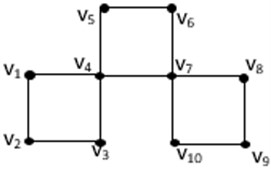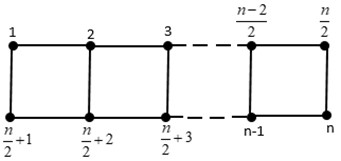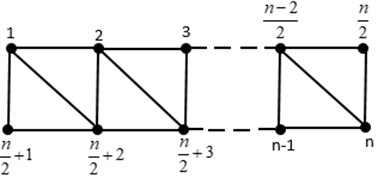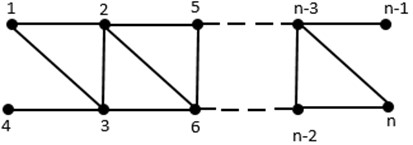Abstract
Numerous applications, like robot navigation, network verification and discovery, geographical routing protocols, and combinatorial optimization, make use of the metric dimension and connected metric dimension of graphs. In this work, the connected metric dimension types of ladder graphs, namely, ladder, circular, open, and triangular ladder graphs, as well as open diagonal and slanting ladder graphs, are studied.
Highlights
- Recognizing numerous applications of the connected metric dimension types, including robot navigation, network verification and discovery, geographical routing protocols, and combinatorial optimization.
- Making use of the metric dimension and connected metric dimension of graphs.
- Studying the connected metric dimension types of ladder graphs, namely, ladder, circular, open, and triangular ladder graphs, as well as open diagonal and slanting ladder graphs.
1. Introduction
In [1, 2], a connected resolving set of graphs was introduced recently. The shortest path between any two vertices in a linked graph is represented by . An ordered vertex set is a metric basis of if has minimum cardinality and the following representation:
is unique for each . A metric basis of is connected if the subgraph produced by is a nontrivial connected subgraph of . The metric dimension and connected metric dimension of , denoted as and , respectively, have the following definitions: Let be the cardinality of , then we have: , is a resolving set of , , is a connected resolving set of .
The connected metric dimension at a vertex , denoted as , is the metric basis of that contains and generates a connected subgraph of ; then:
Slater [3, 4] introduced the concept of metric basis as a locating set of and uses the cardinality of as a locating number to locate an intruder in a network. Harary and Melter independently discovered the ideas of a metric basis as a minimum resolving set of and the cardinality of as a metric dimension [5]. A number of graphs’ metric dimensions are found in [6–15]. The following are the graphs: corona product [6], regular bipartite [7], chain graphs [8], mobius ladder [9], circulant graphs and Cayley hypergraphs [10], heptagonal circular ladder [11], generalized Petersen multigraphs [12], power of total graph [13], friendship graph [14], and quartz graph [15]. Specifically, the authors in [1] studied the linked metric dimension of the star network , full graph , cycle graph , route graph , and wheel graph . The findings show that the cycle graph , , and the route graph , , both have connected metric dimensions that are equal to 2, whereas it is for the star graph , , is , and for the complete graph , , is . According to [2], the connected metric dimension of the wheel graph , , is , while it is for the Petersen graph is 4, and if is an end vertex of the tree , then it is at a vertex of ; otherwise, it is at a vertex of that is 2. Further information might be found in the literature [16-22], and some future notions may be applied to some applications like [23, 24].
To illustrate the ideas of metric dimension with its connected one, we plot in Fig. 1 the –snake graph.
Fig. 13C4-Snake graph G with dimG=3 and cdimG=5

The set is a metric basis of , due to the representations for the vertices of are distinct. Since the representations , , , , , , , , , for the vertices of are different, the set is a metric basis of . Therefore, , and the subgraph induced by is disconnected. As a result, and are not connected resolving sets. To be more precise, no 3-element subset of is a connected resolving set. Given that the representations , , , , , , , , are distinct, the set is a connected resolving set. Therefore, . However, we aim in this article to examine the connected metric dimension of a class of ladder graphs that includes slanting, open diagonal, triangular, open, circular, and open ladder graphs.
2. Applications of ladder graph
We present three applications pertaining to ladder graphs in this section. The three uses listed above and many more inspire us to study the uniquely elegant labelling for the ladder graph. The first application that is filed is in electronics. Resistor ladder networks are a quick and inexpensive way to do digital-to-analog conversion (DAC). The binary weighted ladder and the R/2R ladder are the two most widely used networks. Both devices can convert digital voltage information to analogue, but due to its greater accuracy and simple construction, the R/2R ladder has gained more popularity. The second application is electrical technology. The ladder flow graph is made using Ohm's equation and the two Kirchhoff equations. After that, the graph is inverted so that only forward paths are visible. The reciprocal of the total number of paths that could possibly lead from the output to the input node is the transfer function in the case of a simple ladder. If ladders with internal generators are dependent or independent, the transfer function can be found using similar methods with slight adjustments. Other relations, such as the input impedance and transfer admittance, can also be found using the flow graph. The third application is wireless communication. Over time, an increasing number of wireless networks have been developed to provide wire-free communication between any two devices (computers, phones, etc.). Nevertheless, there aren’t enough radio frequencies accessible for wireless communication (just 11 channels in the 2.4 GHz range are available for all WiFi transmissions in the US). It is essential to provide a workable manner to offer safe communications in industries like phones, mobile, security systems, WiFi, and many others [25]. It annoys me when someone else calls while I’m on the phone. This irritation is caused by interference from uncontrolled simultaneous transmissions [26]. Resonance or interference between two sufficiently adjacent channels can cause damage to communication. Interference can be prevented with the proper channel assignment. To arrive at a solution, Hale [27-30] conceptualized the problem as a graph (vertex) coloring model, which we now refer to as the coloring. Consider about the different transmitters and stations that are out there. In order to minimize interference, a channel must be assigned to each transmitter or station. Time-sensitive or error-sensitive communication may suffer from the interference phenomenon if transmitters are placed too close to one another either physically or through the frequency channels they use. To minimize interference, any two “close” transmitters ought to differ as much as possible from one another.
3. Results
Note that the two paths and are the Cartesian products of a ladder graph .
Theorem 3.1. We have ,
Fig. 2Ladder graph Ln

Proof. Herein, we select as . In this regard, we shall study each of the vertex representations of such thatfor with respect to . In other words, we have:
The set has an induced subgraph that is connected, and as previously demonstrated, the vertices in graph have unique representations. Despite not always being the lowest limit, this implies that is a connected resolving set. Therefore, is an upper bound. Thus, is demonstrated. Given a connected resolving set , we assume that , and is another minimum connected resolving set.
In the case that we choose an ordered set:
for which the two vertices , are exist so that:
This is not the case; is not a connected resolving set as assumed. The lowest bound is therefore .
Corollary 3.2. If the ladder graph (, , , is circular, then:
Fig. 3Circular Ladder graph C(Ln)

Theorem 3.3. If the ladder graph , is open, then
Fig. 4Open ladder graph OLn

Proof. Consider we have . With respect to , we take into consideration the following representations of vertices , , . So, we have:
Although the induced subgraph of is clearly connected and the representations of the vertices in graph are different, this does not necessarily imply that is a connected resolving set. For this reason, is an upper bound.
We now demonstrate that . Given a connected resolving set with . Let be an additional minimal connected resolving set. Let us choose an ordered set:
for which there are two vertices , such that:
It is not the case that is a connected resolving set, as implied. Thus, is the lower bound. Ultimately, .
Theorem 3.4. For , for which is a triangular ladder graph .
Fig. 5Triangular Ladder graph TLn

Proof. For such that , we take into consideration a connected resolving set of () as the set . The vertices’ representations in connection to are given as follows:
The unique vertex representations in graph suggest that is a connected resolving set, and as can be seen above, the induced subgraph of is indeed connected, but this is not always the case. Therefore, is an upper bound. Thus, we demonstrate that .
Given a connected resolving set , . Let be an additional minimal connected resolving set. When we choose an ordered set:
Obviously, we can see that , for which:
It is not the case that is a connected resolving set, as implied. Hence, the lower bound is . Therefore, we have .
Corollary 3.5. For an open triangular ladder , we have , .
Fig. 6Open triangular Ladder O(TLn)

Theorem 3.6. If is a Slanting ladder graph, then , for .
Fig. 7Slanting Ladder SLn

Proof. By taking into consideration with respect to, we assume that is a connected resolving set for () in which , . This implies:
The unique vertex representations in graph suggest that is a connected resolving set, and as can be shown above, the induced subgraph of is clearly connected, but this is not always the case we desire. Because of this, is an upper bound. Thus, we demonstrate that .
Given a connected resolving set , with . Let be an additional minimal connected resolving set. In the event that we choose the following ordered set:
for which , satisfying:
It will not be a connected resolving set if, in contrast to the assumption, we choose an ordered . As a consequence, the lower bound is , and hence .
Theorem 3.7. If the graph is an open diagonal ladder, then , .
Proof. Take into consideration the connected resolving set of () for which , , and the set . With respect to, consider as follows:
In graph , the vertex representations are unique and the induced subgraph of is undoubtedly connected, as can be observed above. This suggests that is a connected resolving set, though it need not be the lowest bound. For this reason, is an upper bound, and thus we demonstrate that .
Fig. 8Open diagonal ladder graph O(DLn)

Given a connected resolving set with . Let be an extra minimal connected resolving set. Assume that we choose the following ordered set:
for which , satisfying:
It will not be a connected resolving set if, in contrast to the assumption, we choose an ordered . As a consequence, the lower bound is , and hence .
4. Conclusions
The constant metric dimension of an open triangular ladder is 3. There are several types of ladder graphs with unbounded metric dimensions as , circular, open, triangular, slanting, and open diagonal. Our approach will be extended to ladder-class graph subdivisions in the future.
References
-
V. Saenpholphat and P. Zhang, “Connected resolvability of graphs,” Czechoslovak Mathematical Journal, Vol. 53, No. 4, pp. 827–840, Dec. 2003, https://doi.org/10.1023/b:cmaj.0000024524.43125.cd
-
L. Eroh, C. X. Kang, and E. Yi, “The connected metric dimension at a vertex of a graph,” Theoretical Computer Science, Vol. 806, pp. 53–69, Feb. 2020, https://doi.org/10.1016/j.tcs.2018.11.002
-
P. J. Slater, “Leaves of trees,” Congressus Numerantium, Vol. 14, pp. 549–559, 1975.
-
P. J. Slater, “Dominating and reference sets in a graph,” Journal of Mathematical Physics, Vol. 22, No. 4, pp. 445–455, 1988.
-
F. Harary and R. A. Melter, “On the metric dimension of a graph,” Ars Combinatoria, Vol. 2, pp. 191–195, 1976.
-
I. G. Yero, D. Kuziak, and J. A. Rodríguez-Velázquez, “On the metric dimension of corona product graphs,” Computers and Mathematics with Applications, Vol. 61, No. 9, pp. 2793–2798, May 2011, https://doi.org/10.1016/j.camwa.2011.03.046
-
S. W. Saputro, E. T. Baskoro, A. N. M. Salman, D. Suprijanto, and M. Baca, “The metric dimension of regular bipartite graphs,” Bulletin mathématique de la Société des Sciences Mathématiques de Roumanie, pp. 15–28, Jan. 2011.
-
H. Fernau, P. Heggernes, P. van T. Hof, D. Meister, and R. Saei, “Computing the metric dimension for chain graphs,” Information Processing Letters, Vol. 115, No. 9, pp. 671–676, Sep. 2015, https://doi.org/10.1016/j.ipl.2015.04.006
-
Mobeen Munir, “Metric dimension of the mobius ladder,” Ars Combinatoria, Vol. 135, pp. 249–256, Jan. 2017.
-
A. Borchert and S. Gosselin, “The metric dimension of circulant graphs and Cayley hypergraphs,” Utilitas Mathematica, Vol. 106, pp. 125–147, Mar. 2018.
-
S. K. Sharma and V. K. Bhat, “Metric dimension of heptagonal circular ladder,” Discrete Mathematics, Algorithms and Applications, Vol. 13, No. 1, p. 2050095, Aug. 2020, https://doi.org/10.1142/s1793830920500950
-
M. Imran, M. K. Siddiqui, and R. Naeem, “On the metric dimension of generalized Petersen multigraphs,” IEEE Access, Vol. 6, pp. 74328–74338, Jan. 2018, https://doi.org/10.1109/access.2018.2883556
-
S. Nawaz, M. Ali, M. A. Khan, and S. Khan, “Computing metric dimension of power of total graph,” IEEE Access, Vol. 9, pp. 74550–74561, Jan. 2021, https://doi.org/10.1109/access.2021.3072554
-
M. Mulyono and W. Wulandari, “The metric dimension of friendship graph Fn, lollipop graph Lm,n and Petersen graph Pn, m,” Bulletin of Mathematics, Vol. 8, No. 2, pp. 117–124, 2016.
-
A. N. A. Koam, A. Ahmad, M. S. Alatawi, M. F. Nadeem, and M. Azeem, “Computation of metric-based resolvability of quartz without pendant nodes,” IEEE Access, Vol. 9, pp. 151834–151840, Jan. 2021, https://doi.org/10.1109/access.2021.3126455
-
B. Mohamed, L. Mohaisen, and M. Amin, “Computing connected resolvability of graphs using binary enhanced harris hawks optimization,” Intelligent Automation and Soft Computing, Vol. 36, No. 2, pp. 2349–2361, Jan. 2023, https://doi.org/10.32604/iasc.2023.032930
-
B. Mohamed, L. Mohaisen, and M. Amin, “Binary equilibrium optimization algorithm for computing connected domination metric dimension problem,” Scientific Programming, Vol. 2022, pp. 1–15, Oct. 2022, https://doi.org/10.1155/2022/6076369
-
I. M. Batiha, A. A. Abubaker, I. H. Jebril, S. B. Al-Shaikh, and K. Matarneh, “New algorithms for dealing with fractional initial value problems,” Axioms, Vol. 12, No. 5, p. 488, May 2023, https://doi.org/10.3390/axioms12050488
-
H. Al-Zoubi, H. Alzaareer, A. Zraiqat, T. Hamadneh, and W. Al-Mashaleh, “On ruled surfaces of coordinate finite type,” WSEAS Transactions on Mathematics, Vol. 21, pp. 765–769, Nov. 2022, https://doi.org/10.37394/23206.2022.21.87
-
S. Klavžar and D. Kuziak, “Nonlocal metric dimension of graphs,” Bulletin of the Malaysian Mathematical Sciences Society, Vol. 46, No. 2, pp. 1–14, Jan. 2023, https://doi.org/10.1007/s40840-022-01459-x
-
A. N. A. Koam, A. Ahmad, S. Husain, and M. Azeem, “Mixed metric dimension of hollow coronoid structure,” Ain Shams Engineering Journal, Vol. 14, No. 7, p. 102000, Jul. 2023, https://doi.org/10.1016/j.asej.2022.102000
-
C. Zhang, G. Haidar, M. U. I. Khan, F. Yousafzai, K. Hila, and A. U. I. Khan, “Constant time calculation of the metric dimension of the join of path graphs,” Symmetry, Vol. 15, No. 3, p. 708, Mar. 2023, https://doi.org/10.3390/sym15030708
-
A. Goldsmith, Wireless Communications. Cambridge University Press, 2005, https://doi.org/10.1017/cbo9780511841224
-
I. M. Batiha, S. A. Njadat, R. M. Batyha, A. Zraiqat, A. Dababneh, and S. Momani, “Design fractional-order PID controllers for single-joint robot Arm model,” International Journal of Advances in Soft Computing and its Applications, Vol. 14, No. 2, pp. 97–114, Aug. 2022, https://doi.org/10.15849/ijasca.220720.07
-
Iqbal M. Batiha et al., “Tuning the fractional-order PID-Controller for blood glucose level of diabetic patients,” International Journal of Advances in Soft Computing and its Applications, Vol. 13, No. 2, pp. 1–10, 2021.
-
R. Wakefield, Radio Broadcasting. 1959.
-
W. K. Hale, “Frequency assignment: theory and applications,” Proceedings of the IEEE, Vol. 68, No. 12, pp. 1497–1514, Jan. 1980, https://doi.org/10.1109/proc.1980.11899
-
A. R. Kannan, P. Manivannan, K. Loganathan, K. Prabu, and S. Gyeltshen, “Assignment computations based on average in various ladder graphs,” Journal of Mathematics, Vol. 2022, pp. 1–8, May 2022, https://doi.org/10.1155/2022/2635564
-
I. Saifudin, H. Oktavianto, and L. A. Muharom, “The four-distance domination number in the ladder and star graphs amalgamation result and applications,” JTAM (Jurnal Teori dan Aplikasi Matematika), Vol. 6, No. 2, pp. 235–246, Apr. 2022, https://doi.org/10.31764/jtam.v6i2.6628
-
H. Al-Zoubi, A. K. Akbay, T. Hamadneh, and M. Al-Sabbagh, “Classification of surfaces of coordinate finite type in the Lorentz-Minkowski 3-space,” Axioms, Vol. 11, No. 7, p. 326, Jul. 2022, https://doi.org/10.3390/axioms11070326
About this article
The authors have not disclosed any funding.
The datasets generated during and/or analyzed during the current study are available from the corresponding author on reasonable request.
M. Iqbal Batiha: conceptualization, validation, data curation. Mohamed Amin: methodology, formal analysis, supervision. Basma Mohamed: software, investigation. Iqbal H. Jebril: resources, visualization, supervision.
The authors declare that they have no conflict of interest.
